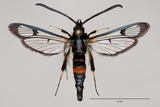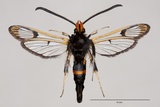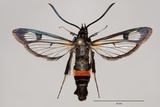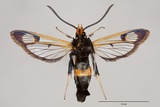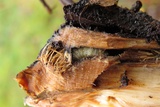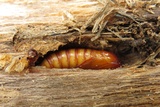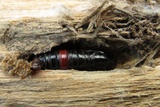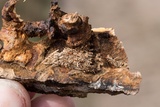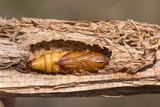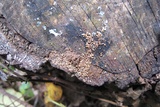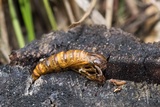Thamnosphecia culiciformis (Linnaeus, 1758) Species
Last modified: Dec. 17, 2024, 12:42 p.m.
A rare species in Belgium, though observed in most provinces and mainly known from the Kempen (AN, LI) and the south of the country.
This species is considered Endangered according to the IUCN Red List category for Flanders 2023.
Traditionally, this species was placed in the genus Synanthedon, but in a recent review of the generic systematics of the polyphyletic genus Synanthedon Hübner, 1819, O. G. Gorbunov removed Thamnosphecia from synonymy as a separate genus of which Sphinx culiciformis Linnaeus, 1758 is the type-species (Gorbunov O. G. 2024a). This species now belongs to the genus Thamnosphecia.
Details
- Classification
- Family: Sesiidae > Subfamily: Sesiinae > Tribus: Synanthedonini > Genus: Thamnosphecia > Species: Thamnosphecia culiciformis
- Vernacular names
- Berkenglasvlinder (NL), Large Red-belted Clearwing (EN), Sésie culiciforme (FR), Kleiner Birken-Glasflügler (DE)
- First mention in Belgium
- De Sélys-Longchamps E. 1837. Catalogue des Lépidoptères ou Papillons de la Belgique, précédé du tableau des Libellulines de ce pays. — — : 1–29. On page 21 (as Sesia Culiciformis). view page
- Status
-
Native
Distribution
Imago
S. culiciformis is a medium-sized species (wingspan 20–28 mm) and is black with a red band on the abdomen. This species is often confused with S. myopaeformis although there are some clear morphological differences. In S. culiciformis the base of the wings is always somewhat orange, but black in S. myopaeformis. The colour of the underside of the palps gives another unmistakable characteristic: it is clear orange in S. culiciformis and white (in males) or black (in females) in S. myopaeformis.
Mine
The larva makes mines in the sap-rich region between bark and wood. If living in a cut tree, a gallery is sometimes gnawed in the wood itself where, at the end, the cocoon is constructed. In these cases the imago emerges from the wood itself instead of between the bark and wood, which is more usual.
Bionomics
The female deposits the eggs near damaged places on the tree. Very often this is a cut Betula tree that was felled one or at most two or three years before. In any case, the tree must still be alive. Trees that were already old when they were felled are apparently less attractive. Eggs are also laid on cancerous swellings on Betula and also on young Betula or Alnus trees.
The caterpillar lives, feeding on the sap-stream, between bark and wood and constructs already a cocoon in autumn. Consequently, this species completes its development in one year (in Belgium). The cocoon is usually built between wood and bark, whence the imago will emerge. When a larval gallery has extended into the wood itself, emergence takes place at the side of the trunk or often even at the cut surface.
In young trees, both Betula and Alnus, the caterpillar lives closer to the root in the centre of the stem.
Flight periods
The adults fly, depending on the micro-climate, from late April till June. Rarely an imago is still seen in July. The flight period is short with this species.
